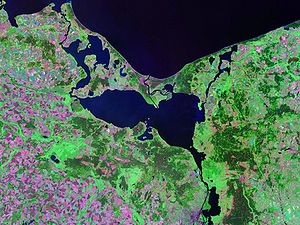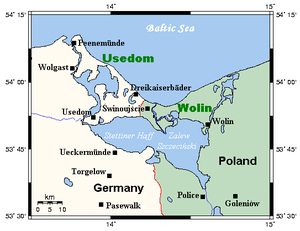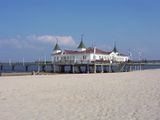Usedom
 Landsat map of the Usedom-Wolin area |
|
 |
|
| Geography | |
|---|---|
| Location | Baltic Sea |
| Area | 445 km2 (171.8 sq mi) |
| Country | |
|
Germany
|
|
| State | |
| District | Ostvorpommern |
|
Poland
|
|
| Voivodeship | |
| Demographics | |
| Population | 76,500 |
| Density | 172 /km2 (445 /sq mi) |
| Ethnic groups | Germans, Poles |
Usedom (German: Usedom [ˈuːzədɔm], Polish: Uznam [ˈuznam]) is a Baltic Sea island on the border between Germany and Poland. It is situated north of the Szczecin Lagoon (German: Stettiner Haff) estuary of the River Oder in Pomerania. Most of the island belongs to the German district of Ostvorpommern in the Federal State of Mecklenburg-Vorpommern, with the exception of the eastern part and the city of Świnoujście (German: Swinemünde) which is in Polish West Pomeranian Voivodeship. Its area is 445 km² (the German part 373 km²; the Polish part 72 km²).
Its population is 76,500 (the German part 31,500; the Polish part 45,000).
Contents |
Geography
The island is separated to the east from the neighbouring island of Wolin by the Świna (German: Swine) strait (or river), which is the main route connecting Szczecin Bay with the Pomeranian Bay, a part of the Baltic Sea. The strait between the island and the mainland is called Peenestrom; it is an underwater extension of the valley of the Peene river, which flows into the westernmost part of Szczecin Bay. The island is mostly plain, partly covered by marshes.
The main town on the island is Świnoujście, which has more inhabitants than the rest of the island. Another town, giving its name to the island, is called Usedom. The largest municipality in the German part is Heringsdorf (from 2005 to 2006 called Dreikaiserbäder (which means "Three Emperors' Baths"). There are many popular tourist resorts on the northern coast, including the three Dreikaiserbäder cities of Ahlbeck, Heringsdorf and Bansin, as well as Świnoujście and Zinnowitz.
Economic activities include agriculture, fishing, animal husbandry, food processing and timber production.
History
Settled since the Stone Age, the area was inhabited by Germanic Rugians, before the Polabian Slavs moved in during the 5th, 6th and 7th centuries. Around the island, Wendish/Scandinavian trade centres such as Vineta/Jomsborg and Menzlin were established. In 1128 the Pomeranian Duke Wartislaw I was converted to Christianity through the efforts of Otto of Bamberg. In 1155 the Premonstratensians established a monastery in Grobe, generally known as Usedom Abbey, which in 1309 was moved to the village of Pudagla. In the meantime, a Cistercian nunnery was founded in Krummin and soon almost the whole island was in the possession of one or the other. During the Reformation, ownership passed to the Slavic dukes of Pomerania, who took over the island.
During the Thirty Years' War, on June 26, 1630, the Swedish Army under King Gustav Adolf II landed in the village of Peenemünde, located on the Peene river (Polish: Piana). Usedom was annexed by Sweden after the war for almost a century, until in 1720 it was sold for 2 million thalers to the Prussian king Frederick William I. In 1740 Frederick the Great developed a seaport in Swinemünde.
The small village of Peenemünde came to prominence again during World War II. The Luftwaffe tested their missiles and rockets, including the V-1 and V-2 in the locality. Germany used thousands of slave labourers on Usedom during World War II.
In 1945 the eastern part of the island, together with the city and port of Świnoujście, was assigned to Poland by the Potsdam Conference, the German inhabitants being expelled to the west. The territory was populated with Poles who had in turn been expelled by the Soviet Union from lands east of the Bug River.
Tourism
The Isle of Usedom is one of Germany's major holiday and recreation areas due to its beaches, its natural beauty and a number of elegant seaside towns such as Zinnowitz and Heringsdorf, which have been frequented by the German and international nobility as well as the general public. Many hotels and bed and breakfast establishments are available on both sides of the German-Polish border. In addition to the coastline, the hinterland features nature reserves, castles, lakes and historic villages. Points of interest include:
- Usedoms Botanischer Garten Mellenthin, a botanical garden
Gallery
 View from the pier in Bansin |
 Pier in Ahlbeck |
 Villa Oechsler in Heringsdorf |
Bansin |
|
Bäderarchitektur in Zinnowitz |
 Church in Ahlbeck |
Oder-Neisse line between Świnoujście and Ahlbeck |
A view of the Świna bank on Usedom, Świnoujście |
See also
- List of divided islands
- Home Army and V1 and V2
References
External links
|
|||||||||||||||||||||||
|
||||||||||||||||||||||||||||||||||||||||||||
|
|||||||||||||||||||||||||||||||||||||||||||||||||||||||||||||||
|
|||||||
